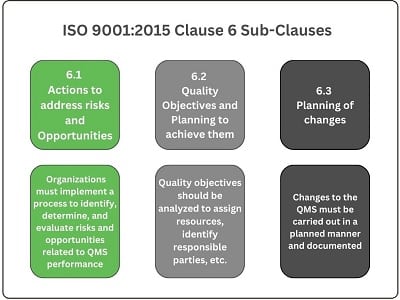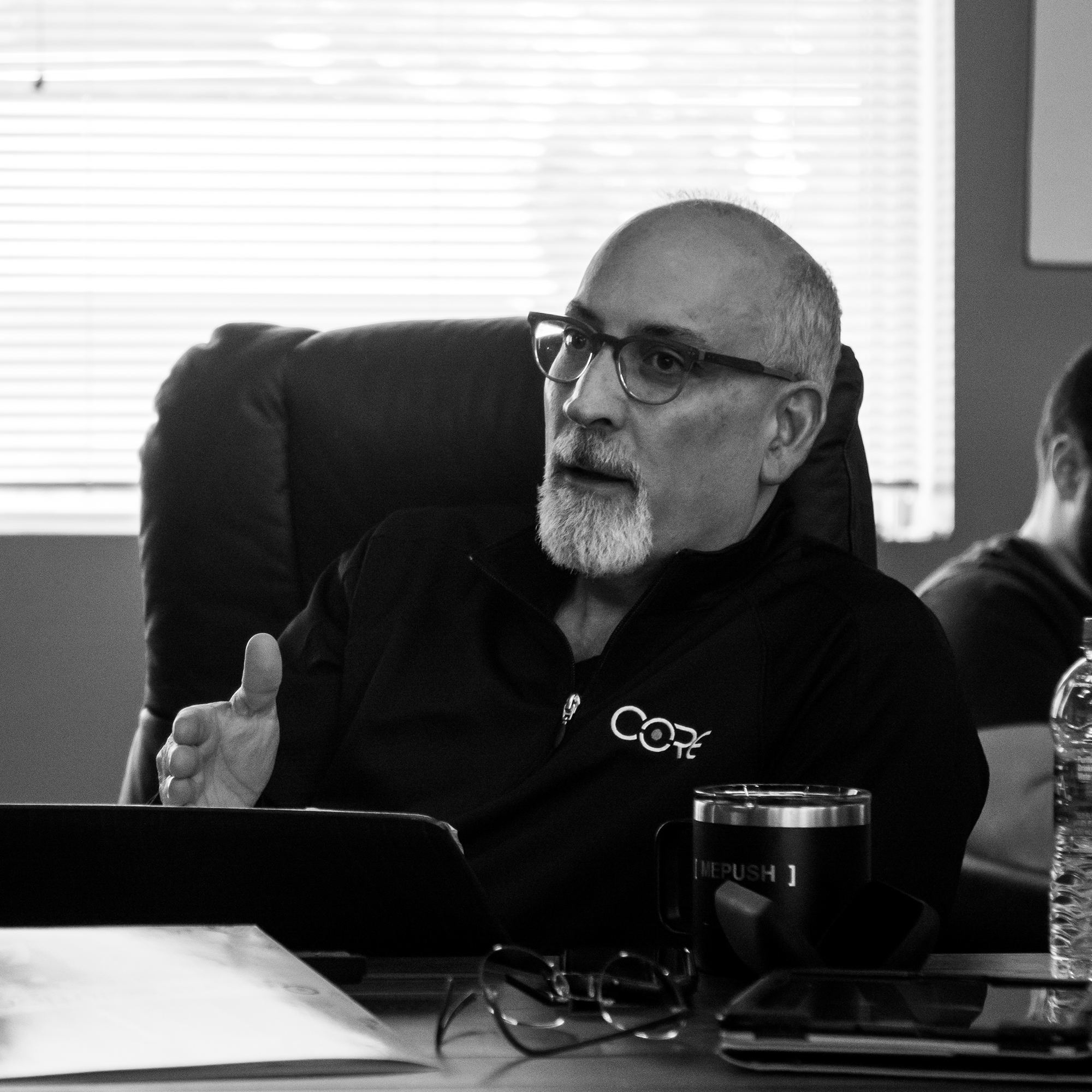ISO 9001:2015 Clause 6
What is the ISO 9001:2015 Clause 6 About?
Clause 6 of the ISO 9001:2015 standard, titled “Planning,” serves the purpose of establishing a systematic approach to quality management system (QMS) planning within an organization. The overall purpose of this clause is to ensure that organizations identify and address the necessary actions to achieve their quality objectives, meet customer requirements, and continually improve their QMS.
Clause 6 emphasizes the importance of a proactive approach to managing the QMS. It provides organizations with a framework to establish clear objectives, define action plans, and allocate resources to achieve their quality goals. Effective planning is critical to the successful implementation and ongoing effectiveness of the QMS, supporting the organization’s ability to consistently deliver products and services that meet customer requirements.
The Specific Objectives of Clause 6, Planning, are as follows:
1. Addressing Risks and Opportunities:
Organizations are required to identify and assess the risks and opportunities that can impact their ability to provide products and services that meet customer requirements and enhance customer satisfaction. This involves considering internal and external factors and taking appropriate actions to mitigate risks and exploit opportunities.
Get a Free Quote
2. Quality Objectives:
Organizations must establish measurable quality objectives at relevant functions and levels. These objectives should be consistent with the organization’s quality policy, relevant to customer requirements, and provide a framework for continual improvement. The planning process involves setting targets, defining indicators, and establishing a mechanism to monitor and evaluate the achievement of these objectives.
3. Planning for Changes:
Organizations are required to plan and implement changes in their QMS to ensure the continued effectiveness of the system. This includes identifying the need for changes, assessing their potential impacts, determining the resources required, and defining the methods for implementing and evaluating the changes.
4. Contingency Planning:
Organizations must consider potential risks and develop contingency plans to address events that could disrupt their ability to meet customer requirements or maintain the effectiveness of the QMS. This involves identifying critical processes, developing response strategies, and establishing appropriate preventive and corrective measures.
5. Documented Information:
The planning process also involves determining the necessary documented information to support the effective operation of the QMS. This includes defining the structure and content of documented procedures, work instructions, forms, and records that are required for the implementation and control of the QMS processes.
By addressing the objectives of Clause 6, organizations establish a systematic approach to planning their QMS, ensuring that all necessary actions are identified and implemented to achieve quality objectives and meet customer expectations. The planning process helps organizations anticipate and address potential risks, align resources effectively, and drive continual improvement.

Complying with Clause 6 of the ISO 9001:2015 Standard:
Complying with Clause 6, titled “Planning,” in the ISO 9001 Standard involves establishing systematic processes for planning the quality management system (QMS) and its associated processes. Here are some examples of how an organization can comply with Clause 6:
1. Develop a quality planning process:
Establish a structured process for planning the QMS, including the identification of quality objectives, resource requirements, and the determination of key performance indicators. This process should involve relevant stakeholders and ensure alignment with the organization’s strategic goals.
2. Conduct a SWOT analysis:
Perform a SWOT (Strengths, Weaknesses, Opportunities, and Threats) analysis to identify the internal strengths and weaknesses of the organization and external opportunities and threats. Use the findings to inform the planning process and identify areas for improvement.
3. Establish quality objectives:
Define specific, measurable, achievable, relevant, and time-bound (SMART) quality objectives that align with the organization’s overall goals. Ensure that these objectives are communicated to relevant personnel and regularly monitored for progress.
4. Develop action plans:
Create action plans to achieve the defined quality objectives. These plans should outline the necessary steps, responsibilities, timelines, and resource requirements for implementing and monitoring the actions.
5. Determine resource requirements:
Identify the resources (e.g., personnel, infrastructure, technology, finances) needed to support the QMS and its processes. Allocate resources appropriately to ensure the effective implementation of the QMS and the achievement of quality objectives.
6. Conduct risk assessments:
Evaluate the risks associated with the QMS processes and activities. Identify potential risks, assess their likelihood and impact, and develop risk mitigation strategies to minimize their negative effects on quality performance.
7. Define process controls:
Establish controls for key processes to ensure their effectiveness and compliance with quality requirements. Define process inputs, outputs, criteria, and measurement methods. Implement control measures to monitor and verify the performance of the processes.
8. Consider the needs of interested parties:
Identify the needs and expectations of interested parties, such as customers, suppliers, and regulatory authorities. Consider these requirements when planning the QMS and its processes to ensure customer satisfaction and compliance with relevant standards and regulations.
9. Establish a document control system:
Implement a document control system to manage the creation, review, approval, distribution, and control of QMS-related documents and records. Ensure that documents are properly maintained, up-to-date, and accessible to relevant personnel.
10. Continually review and improve the planning process:
Regularly review the effectiveness of the planning process and its outcomes. Use feedback, data analysis, and lessons learned to identify areas for improvement and make necessary adjustments to the planning approach.
Compliance with Clause 6 ensures that the organization has a structured and well-defined planning process for the QMS. By setting clear quality objectives, allocating resources, addressing risks, and establishing effective controls, organizations can enhance their ability to achieve quality goals, meet customer requirements, and drive continual improvement.
The History of Clause 6 of the ISO9001 Standard:
Clause 6 of the ISO 9001 standard, titled “Planning,” has evolved throughout the history of the standard. Let’s explore the changes and developments in Clause 6 over the different versions of ISO 9001:
ISO 9001:1987:
The initial version of ISO 9001, published in 1987, did not have a dedicated clause for “Planning.” The standard primarily focused on quality assurance and control processes without explicitly addressing the planning aspect of a quality management system (QMS).
ISO 9001:1994:
In the 1994 revision, ISO 9001 introduced a clause titled “Quality System,” which included requirements related to the “Quality Manual” and “Quality Planning.” However, the planning aspect was not emphasized as a separate clause.
ISO 9001:2000:
The year 2000 brought significant changes to ISO 9001, including the introduction of the High-Level Structure (HLS) developed by ISO. Clause 5, titled “Management Responsibility,” included requirements for top management to ensure that quality objectives were established. However, there was no dedicated clause specifically addressing planning.
ISO 9001:2008:
The 2008 revision introduced Clause 5.4, titled “Planning.” This marked the first inclusion of a specific clause dedicated to planning in the ISO 9001 standard. The requirements under this clause focused on the planning of product realization processes, including quality objectives, planning for product realization, and establishing quality plans.
ISO 9001:2015:
The 2015 revision of ISO 9001 brought significant changes to Clause 6. It was restructured and expanded to encompass a more comprehensive approach to planning within the QMS. The revised clause, titled “Planning,” includes requirements related to organizational context, interested parties, risk-based thinking, and quality objectives.
ISO 9001:2015 introduced specific sub-clauses under Clause 6, including:
Clause 6.1 Actions to Address Risks and Opportunities
Clause 6.2 Quality Objectives and Planning to Achieve Them
Clause 6.3 Planning of Changes
The current version of ISO 9001, ISO 9001:2015, places a strong emphasis on planning as a fundamental aspect of a QMS. It requires organizations to identify and address risks and opportunities, establish quality objectives, and plan changes to the QMS. The introduction of risk-based thinking in Clause 6 emphasizes the importance of considering potential risks and opportunities to enhance performance and prevent issues.
By incorporating planning requirements, ISO 9001:2015 ensures that organizations take a proactive approach to identify and mitigate risks, establish clear objectives, and plan activities to achieve those objectives. This approach promotes systematic and strategic thinking, resulting in better performance, enhanced customer satisfaction, and continual improvement of the QMS.
Consulting Support for ISO 9001
Every year, we help hundreds of small businesses achieve ISO 9001 certification. Support for ISO 9001 is available through any of our Consulting Programs
As an American business with a story like yours, we know that time is valuable. Our expert consultants are here to take on the difficult, technical aspects of certification so you can focus on your business. They’ll work with you every step of the way until you’re successfully certified.
Interested? Get a Free Quote.
In many industries, ISO 9001 has become a supply-chain requirement. When landing a big contract, ISO 9001 certification could make all the difference.
About Scott Dawson
Since 2010, Scott Dawson, President of Core Business Solutions, has been an active voting member of the U.S. Technical Advisory Group (TAG) to ISO Technical Committee 176 (TC 176). TAG 176 members meet to discuss and develop U.S. positions for Quality Management standards, including ISO 9001:2015, which will be revised in 2025.


About Core Business Solutions
"Core Business Solutions was started by my brother, Mike Dawson, and myself, true entrepreneurs at heart looking for a better way to make a living and help small businesses improve the quality of the products and services they provide.
The bottom line: we are real people that have developed a team to come along side you to help you grow and succeed."
-- Scott Dawson, President
Related Standards
We provide consulting support for various other standards, as well as support for companies seeking multiple certifications through an Integrated Management System.
AS9100
Aerospace Manufacturers
AS9120
Aerospace Distributors
ISO 14001
Environmental Management Systems
ISO 27001
Information Security Management Systems
ISO 20000-1
Service Management Systems
ISO 45001
OH&S Management Systems
ISO 13485
Medical Device Manufacturers
AS9100
AS9120
ISO 14001
ISO
20000-1
ISO 27001
ISO 45001
ISO 13485
Equip Your Business to Meet ISO 9001 With CORE
At Core Business Solutions, we’re here to equip your company for success in meeting ISO 9001 requirements. We’ve helped hundreds of small businesses grow and deliver the best solutions to their clients. We provide ISO training services, consulting help, and compliance software and to help you get certified and stay certified. We focus on optimizing your processes and helping you implement an ISO-compliant QMS. When you partner with us, you’ll get the tools and help you need for success.
For more information on the ISO 9001:2015 standard, please visit our articles page. You can also call our consulting office at 866-354-0300.
Do you want to update your existing ISO 9001 QMS System or refresh it?
We provide consulting services to assist you in your ISO 9001 Quality Management System refresh. We listen, conduct a gap analysis, update your Quality Policy and any necessary documentation or procedures, find areas of waste or improvement, simplify and automate. And we do it fast. Core offers firm, fixed pricing. Download our information sheet today to learn more or call us at 866-354-0300 Extension 2.
